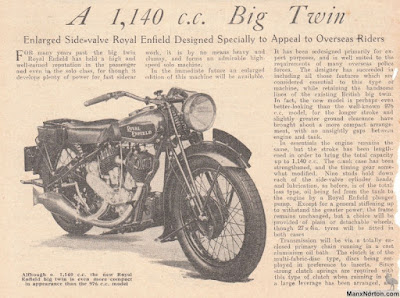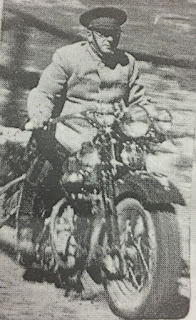 |
| 1933 Royal Enfield factory photo of a lovely V-twin motorcycle. |
In 1933 Royal Enfield built a startlingly beautiful 1,140 cc V-twin motorcycle the company thought was perfect for export, and might be ideal for the police forces of foreign countries. It was improved over previous Royal Enfield V-twins, and it was fast and powerful enough to pull a sidecar at speed.
One of these new V-twins was specially prepared "for the personal use of the President of one of the South American Republics."
This special motorcycle had the four-speed gearbox shift on the right side of the tank, and was finished in cream and chromium plating.
Factory photos of the special motorcycle are in the archives of the Royal Enfield Owners Club UK. But aside from the caption seen in a clipping of one of the photos as published in Motor Cycling magazine of 1933, not much was known about this custom beauty.
Until now.
 |
| Motor Cycling said special bike was for a South American president. |
Royal Enfield Owners Club (UK) archivist Bob Murdoch supplied me with copies of the factory photos of the special motorcycle, and a copy of the clipping from Motor Cycling. He invited me to try to find out more.
Being a crack investigator, I consulted my secret source of information on presidents of South American republics in 1933: Wikipedia.
There were many leaders to consider, as it was a time of political turmoil on the continent of South America. However, none of these men -- soldiers, lawyers, businessmen, public servants -- were known by Wikipedia to have any special interest in motorcycling.
It quickly occurred to me that the problem might be the careless way many people tend to place only Canada and the United States in North America. As a newspaper copyeditor I once corrected a columnist who wrote that Mexico is in South America.
It's in North America.
"But Mexico is SOUTH of the U.S. border!" he argued.
Mostly true; but Mexico is on the landmass of the continent of North America.
South America is, logically, that big continent SOUTH of the countries of Central America, which connect North and South America: Guatemala, Belize, Honduras, El Salvador, Nicaragua, Costa Rica and Panama.
The Motor Cycling caption writer certainly wasn't told what country the special Royal Enfield was bound for. The factory employees who issued the photos to the press probably didn't know the truth. Who ever did know was probably perfectly satisfied to have the information printed incorrectly.
However, once you allow Central America into the list of possible destinations, it wasn't very hard to guess the president for whom the special Royal Enfield was produced,
 |
| Royal Enfield's glorious new V-twin was meant fort export, police use. |
It had to be Jorge Ubico y Castañeda, president of Guatemala from Feb. 14, 1931 to July 4, 1944. A colonel who rose through the ranks to minister of war, he won election as president (he was the only candidate) with U.S. assistance.
Once in office he abandoned democratic pretensions and ruled as an autocrat.
As described by American journalist Chapin Hall in his Los Angeles Times column:
"When President Ubico, of Guatemala, starts on a tour of inspection, which he does several times a year, he doesn’t order out the guard and a special train, but hops on a motorcycle, shouts 'c'mon boys,' and leads a squadron of two-wheelers, each one manned by a government department head."
There's the man to appreciate a cream-and-chrome Royal Enfield V-twin!
Graham Scarth, longtime member of the Royal Enfield Owners Club UK, has made a study of the factory records. I shared my theory about Ubico and asked if the factory records contained any clues. His answer delighted me.
"I have been asked if this bike was in the records before and, because of the South America claim, have always said it was not. A more thorough study of our (incomplete) V-twin records reveals no machines sent to South America at all. There are six recorded as going to Partenheimer in Guatemala though, with three of them dispatched in 1933.
"One of these bikes is listed as having “Special Specification & Finish” and was dispatched in May, 1933. Allied to your research re: Ubico being a motorcycle fanatic, I feel sure this will be the bike in the photos," Graham wrote.
Bingo.
I can't claim to be an expert on leaders of Central American countries. I had learned of Ubico and his fondness for powerful motorcycles in a 2014 article by then intern Christine Miranda in the blog of the Smithsonian National Museum of American History.
She discovered that the Harley-Davidson motorcycle in the museum's collection is one Ubico used in 1942. There's even a photograph of him riding the Harley, and I think you'd agree he looks like the model dictator. (He considered himself Central America's Napoleon and compared himself to Adolf Hitler.)
 |
| President Ubico on his Harley-Davidson. |
Ubico needed to be tough to enforce his will. In an era of "banana republics," he was a friend of the United Fruit Company and supported harsh labor practices. It is easy to imagine that the shiny Harley might have been a gift from those who counted on him to keep the workers in line. (Presumably the 1933 Royal Enfield was worn out by 1942.)
But who had given him that shiny Royal Enfield not long after he first came to power? Remember, three of the Royal Enfield V-twins were imported in 1933, one of them the special machine. Were the other two for his outriders?
The Royal Enfield factory might have provided them as samples, with hopes of an order to equip the entire police force. But a manufacturer would go broke being so generous with samples to random countries far away.
And it seems unlikely that Ubico would have purchased a custom British motorcycle for himself. A friend of the United States, Ubico was definitely NOT a friend of Great Britain. Quite the reverse.
More than any other Guatemalan leader, Ubico claimed neighboring British Honduras as part of Guatemala and, by 1933, he was pressing his claims hard. When Great Britain waved off his demands he stepped up a propaganda campaign, seeking support from the United States and other Central American countries.
Is it possible that the British government, or British interests in Guatemala, contracted with Royal Enfield to supply a distinctly British gift to placate the dictator? A gift of three very nice motorcycles?
If so, it didn't work for long. Soon Ubico would suggest a boycott of British goods, making him hardly the obvious customer for a Royal Enfield motorcycle.
The dispute went on and on, with Ubico constantly raising the ante. He had a postage stamp prepared that showed the area of British Honduras as part of Guatemala (and had it issued, briefly). The British Foreign Office shrugged it all off.
By September, 1940, with Britain fighting alone in Europe, an American military attaché reported that Ubico was thinking of sending a force posing as Nazis into British Honduras and then sending in his army to save the colony from the "Nazis."
That didn't happen. What did happen was that, in 1944, Guatemalans, sick of tyrannical rule, threw him out. Ubico went to the United States, where he died two years later. British Honduras became the independent nation of Belize in 1981.
Where is Ubico's Royal Enfield motorcycle today? I'd like to know.
































Great article David. Wouldn't it be nice to think that the bike is still around, maybe gathering dust in a presidential palace basement somewhere. Given that he fell out with Britain so soon after getting the bike it might just be possible...
ReplyDeleteIt would be great if the motorcycle turned up. Then we would know for absolute certain. And it is a pretty motorcycle.
Delete